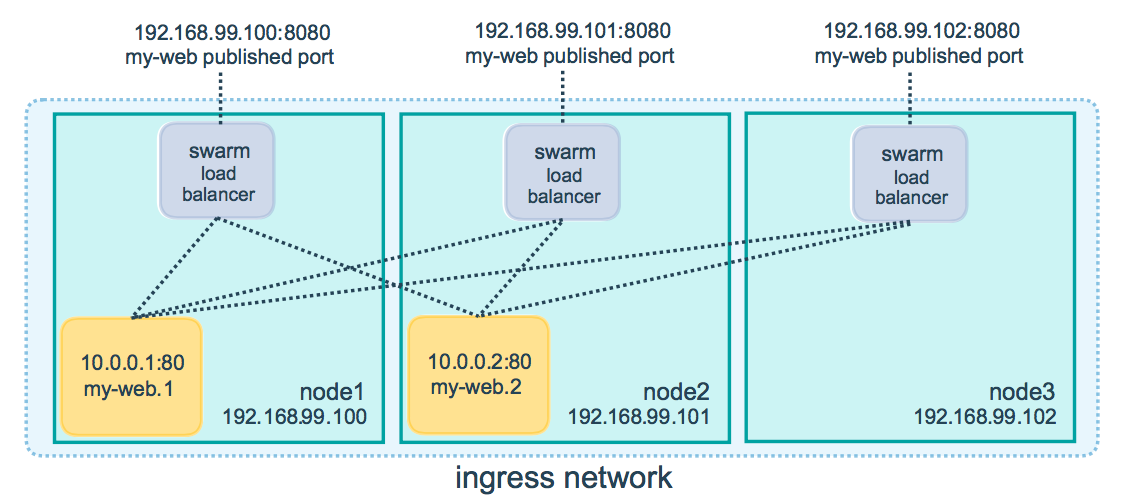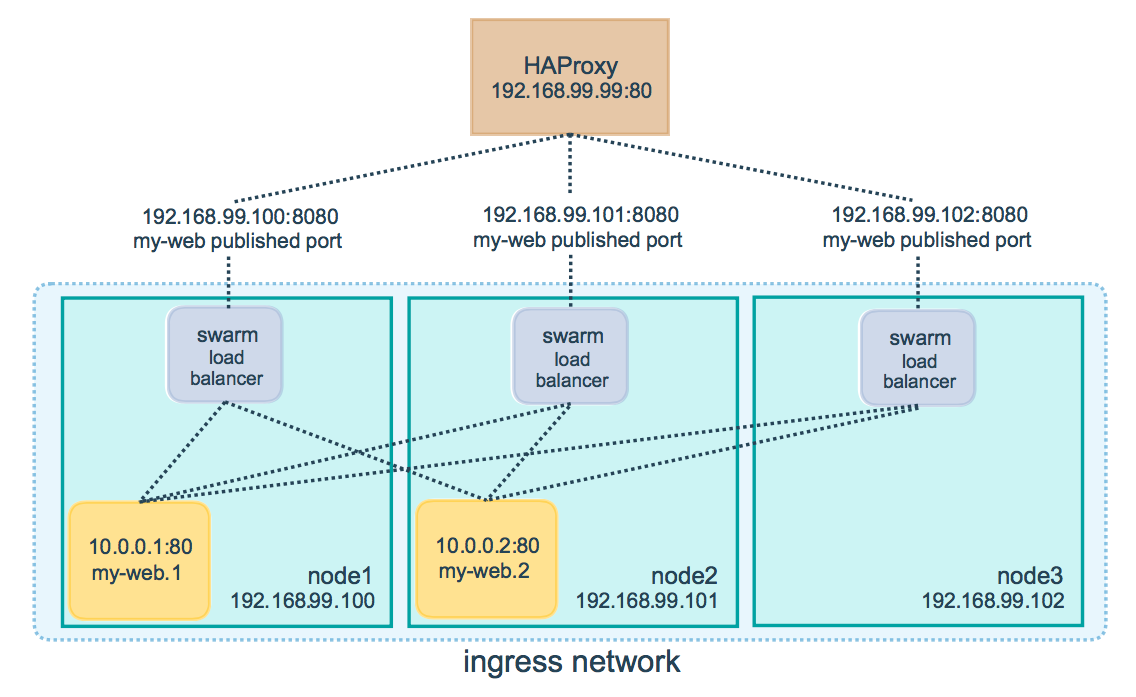Use swarm mode routing mesh
Estimated reading time: 4 minutesDocker Engine swarm mode makes it easy to publish ports for services to make them available to resources outside the swarm. All nodes participate in an ingress routing mesh. The routing mesh enables each node in the swarm to accept connections on published ports for any service running in the swarm, even if there’s no task running on the node. The routing mesh routes all incoming requests to published ports on available nodes to an active container.
In order to use the ingress network in the swarm, you need to have the following ports open between the swarm nodes before you enable swarm mode:
- Port
7946TCP/UDP for container network discovery. - Port
4789UDP for the container ingress network.
You must also open the published port between the swarm nodes and any external resources, such as an external load balancer, that require access to the port.
Publish a port for a service
Use the --publish flag to publish a port when you create a service:
$ docker service create \
--name <SERVICE-NAME> \
--publish <PUBLISHED-PORT>:<TARGET-PORT> \
<IMAGE>
The <TARGET-PORT> is the port where the container listens.
The <PUBLISHED-PORT> is the port where the swarm makes the service available.
For example, the following command publishes port 80 in the nginx container to port 8080 for any node in the swarm:
$ docker service create \
--name my-web \
--publish 8080:80 \
--replicas 2 \
nginx
When you access port 8080 on any node, the swarm load balancer routes your request to an active container.
The routing mesh listens on the published port for any IP address assigned to the node. For externally routable IP addresses, the port is available from outside the host. For all other IP addresses the access is only available from within the host.

You can publish a port for an existing service using the following command:
$ docker service update \
--publish-add <PUBLISHED-PORT>:<TARGET-PORT> \
<SERVICE>
You can use docker service inspect to view the service’s published port. For
instance:
$ docker service inspect --format="{{json .Endpoint.Spec.Ports}}" my-web
[{"Protocol":"tcp","TargetPort":80,"PublishedPort":8080}]
The output shows the <TARGET-PORT> from the containers and the
<PUBLISHED-PORT> where nodes listen for requests for the service.
Publish a port for TCP only or UDP only
By default, when you publish a port, it is a TCP port. You can
specifically publish a UDP port instead of or in addition to a TCP port. When
you publish both TCP and UDP ports, Docker 1.12.2 and earlier require you to
add the suffix /tcp for TCP ports. Otherwise it is optional.
TCP only
The following two commands are equivalent.
$ docker service create --name dns-cache -p 53:53 dns-cache
$ docker service create --name dns-cache -p 53:53/tcp dns-cache
TCP and UDP
$ docker service create --name dns-cache -p 53:53/tcp -p 53:53/udp dns-cache
UDP only
$ docker service create --name dns-cache -p 53:53/udp dns-cache
Configure an external load balancer
You can configure an external load balancer to route requests to a swarm service. For example, you could configure HAProxy to balance requests to an nginx service published to port 8080.

In this case, port 8080 must be open between the load balancer and the nodes in the swarm. The swarm nodes can reside on a private network that is accessible to the proxy server, but that is not publicly accessible.
You can configure the load balancer to balance requests between every node in
the swarm even if there are no tasks scheduled on the node. For example, you
could have the following HAProxy configuration in /etc/haproxy/haproxy.cfg:
global
log /dev/log local0
log /dev/log local1 notice
...snip...
# Configure HAProxy to listen on port 80
frontend http_front
bind *:80
stats uri /haproxy?stats
default_backend http_back
# Configure HAProxy to route requests to swarm nodes on port 8080
backend http_back
balance roundrobin
server node1 192.168.99.100:8080 check
server node2 192.168.99.101:8080 check
server node3 192.168.99.102:8080 check
When you access the HAProxy load balancer on port 80, it forwards requests to nodes in the swarm. The swarm routing mesh routes the request to an active task. If, for any reason the swarm scheduler dispatches tasks to different nodes, you don’t need to reconfigure the load balancer.
You can configure any type of load balancer to route requests to swarm nodes. To learn more about HAProxy, see the HAProxy documentation.